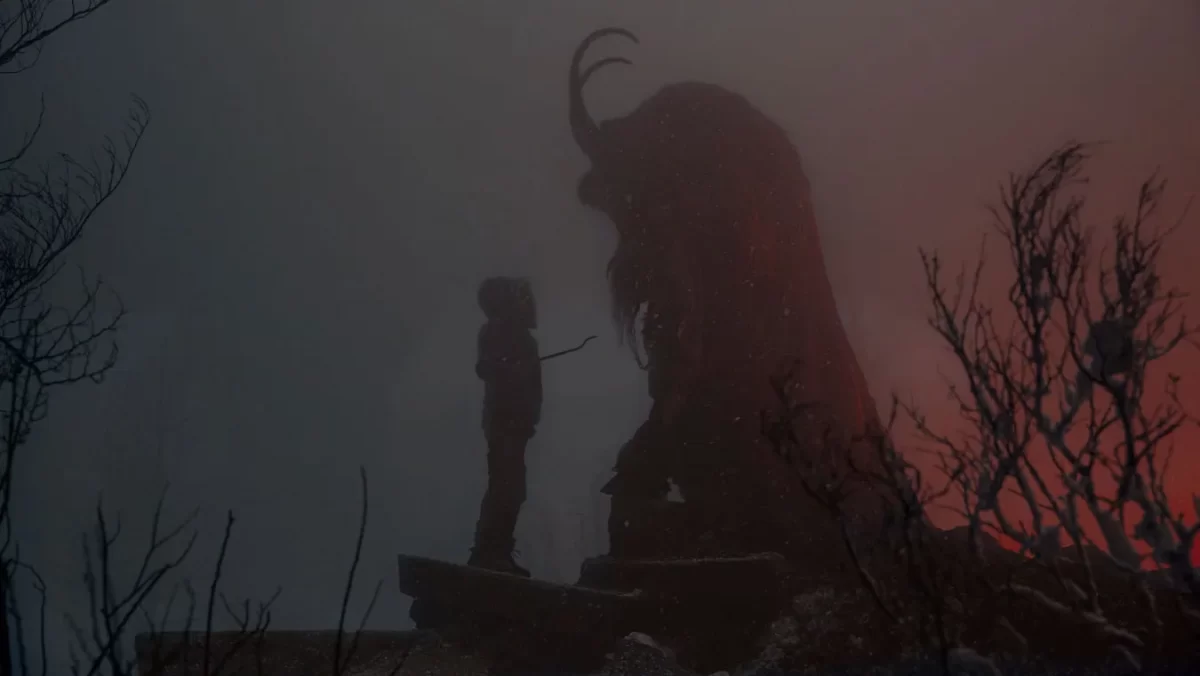By Edward Bayliss
Our current season has so often been relied upon in cinema to accelerate some kind of dramatic effect. Importantly, winter hosts the world’s favourite event in the Christian calendar. Think of charity, love, and compassion, along with accentuated feelings of security and warmth; that is, if you have God and triple glazed windows. Just as easily, winter can be a hellishly frigid wasteland, and if that’s not bad enough, you might find yourself on a Norwegian glacier with Nazi zombies chasing after you (Dead Snow). There is such a thing as winter without Christmas.
Nevertheless, winter cinema isn’t always just a godless freeze, nor is it as simple as warm candles casting long shadows across tastefully decorated drawing rooms. Let’s leave this binary to thaw into a messy puddle and look at two films that toy brilliantly with the season of snow.
Director Michael Dougherty wages war with Christmas – the American Christmas – in his 2015 film, Krampus. The slow motion opening credits show a shopping mall opening to hordes of frenzied shoppers, each looking to get their hands on last minute presents for the festive season. Shots of credit cards, cash, plastic, sickly greens, reds, and golds all drip like syrup before the camera. In this ‘monster of melodrama’, fantastically choreographed fights break out between rival shoppers – even the most grotesque scenes can become beautiful if seen in slow motion. As this plays out, we hear the tinny tune of ‘It’s Beginning to Look a Lot Like Christmas’. It might look like Christmas, but it doesn’t feel like Christmas.
And this is what Krampus does so well. It treads a careful path between the horrific and the familiar, the fantastical and the realities of family dysfunction. The eponymous character originates from Austro-Bavarian folklore, and punishes badly behaved children, almost like an anti-Santa. He absolutely brings with him a menace that will frighten younger audiences, including my 12 year old self upon first viewing. But on rewatching it now what seems especially unnerving to me is the subcurrent of uneasiness on which the film awkwardly floats. The constant darkness of winter, the disorientating use of animation, and the apparent question of dream and reality at the end of the film all threaten our sense of truth and fiction. Beneath the clotting accessories and circumstance of Christmas which Krampus so knowingly flaunts, there are mounting feelings of disillusionment on the part of the audience.
Gasper Noé uses winter sparingly in Climax (2018). For the director, the colour of winter is unmistakably white, with its clinical and undistracting exactness. The notion of mise-en-scène is almost entirely buried under a reliably indifferent blanket of snow. It is in these couple of snow scenes that the camera comes back to its sober sided self, and watches overhead as the story’s fallout unfolds.
Climax is set almost entirely in a remote empty school building in France, 1996. A dance troupe host celebrations as their rehearsals come to a close, though, unbeknownst to them, their sangria is laced with LSD. Noé takes us on a trip quite unlike any other I’ve seen in cinema. It is exhaustingly colourful, even kaleidoscopic, as the camera becomes entranced (the ‘master shot’ in this episode lasts a staggering 42 minutes). Sweaty and claustrophobic, the school rooms and corridors become a labyrinth with dark corners for even darker deeds.
Like a splash of water to the face, we gasp as we escape the school and are met with a bright shock of snow which brings with it a crisp clarity, both in terms of actual visuals and narrative understanding. Noé places a crawling body in frame against the blank canvas snow, presenting an arresting point of comparison between the stuffy slants of light and shadow in the school complex and the ‘freeing’ embrace of the ice cold winter.
When you picture winter in cinema, you might think of snow blizzards so bad they look like TV static, honey tongued dialogues between repulsive characters, and the same old love stories over and over again. But let’s not meet this season’s cinema with a sigh.
Here are a few other films that do interesting things with winter:
Fargo (Joel & Ethan Coen)
The Shining (Kubrick)
Snowpiercer (Bong Joon Ho)
I’m Thinking of Ending Things (Kaufman)
The Thing (Carpenter)
Cool Runnings (Turteltaub)
Groundhog Day (Ramis)
The Hateful Eight (Tarantino)

